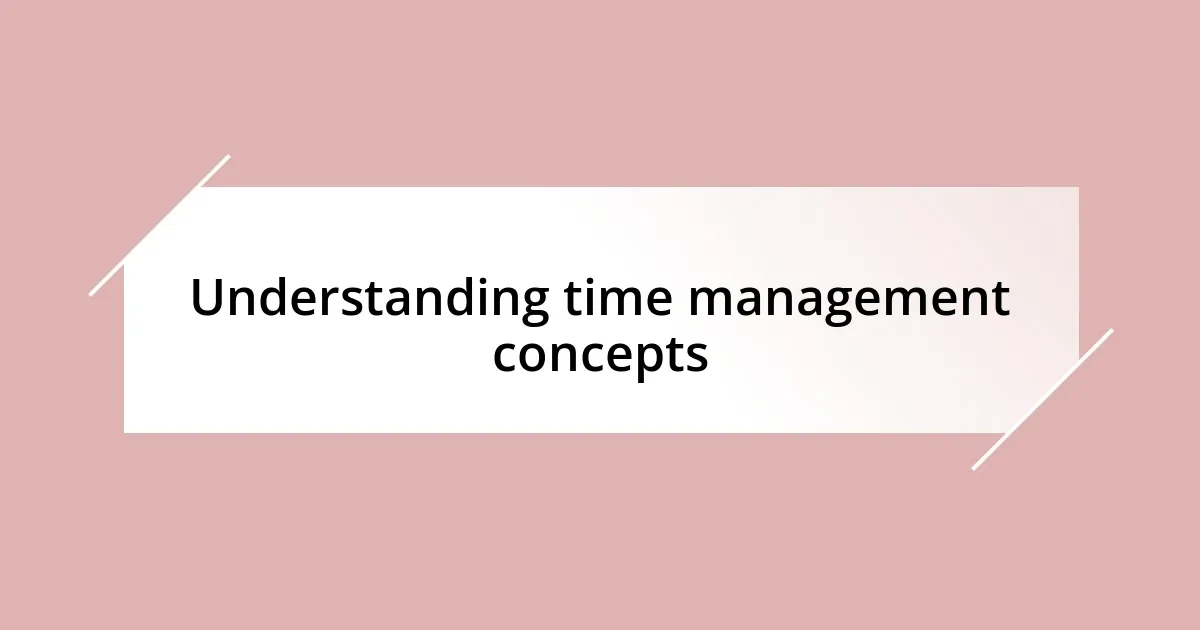Key takeaways:
- Effective time management relies on prioritization, focusing on high-impact tasks over less significant ones.
- Identify personal time wasters like social media and email distractions to regain control over your schedule.
- Set clear, achievable goals using the SMART criteria to make your targets actionable and measurable.
- Regularly reflect and adjust your strategies based on experiences and energy levels to enhance productivity.

Understanding time management concepts
Time management is more than just keeping a calendar; it’s about understanding the value of each minute. I remember a time when I felt overwhelmed with tasks, constantly rushing from one to another without really knowing what I was prioritizing. Have you ever found yourself in that chaotic spiral? Realizing that I needed to identify what truly mattered changed everything for me.
At its core, effective time management hinges on prioritization. I learned that not all tasks hold equal weight and that focusing on high-impact activities yields better results. It’s a bit like curating a playlist: not every song fits the mood, and sometimes, letting go of the less impactful ones creates space for the real hits.
Lastly, I think it’s crucial to recognize that time management is a personal journey. I still find myself revisiting this concept regularly, tweaking my methods as my life evolves. Have you evaluated your own strategies lately? Sometimes a simple shift in perspective can unlock new efficiencies that you never thought possible.

Identifying personal time wasters
Identifying personal time wasters requires a candid self-assessment. For me, scrolling through social media became a sneaky thief of precious hours. I initially thought it was just a short break, only to realize I could easily lose an entire afternoon. Have you ever set out to check your messages only to find yourself watching videos instead? It’s a common trap that many of us fall into.
Another time waster that I’ve battled is the endless email cycle. I once found myself in a rabbit hole, constantly checking for new messages instead of focusing on my priority tasks. This habit not only disrupted my workflow but also left me feeling scattered and unproductive. I made it a point to designate specific times for checking emails, which has significantly improved my efficiency. Have you considered how often you get sidetracked by notifications?
Recognizing these distractions requires honesty. I’ve noticed that once I acknowledged these time wasters, I felt liberated; it empowered me to take control of my schedule. Keeping a log of how I spent my time each day unveiled shocking patterns. What about you? Can you identify your own personal time thieves?
| Time Waster | Impact on Productivity |
|---|---|
| Social Media Scrolling | Can consume hours without realizing it |
| Email Checking | Interrupt focus, leading to scattered thoughts |

Setting clear and achievable goals
Setting clear and achievable goals is like laying the foundation for a sturdy house. I once set an ambitious goal to write a book within three months, but without breaking it down into manageable steps, I found myself feeling overwhelmed and stressed. It’s essential to create goals that are not just lofty dreams but actionable targets that you can track and achieve. Have you ever tried to climb a mountain without understanding the trail?
When crafting goals, I always remind myself to follow the SMART criteria – that’s Specific, Measurable, Achievable, Relevant, and Time-bound. This framework really aligns with my own experiences; for instance, I once aimed to read more books. Instead of saying “I want to read more,” I made it a goal to read one book per month. Not only did it make the target clearer, but it also gave me a sense of accomplishment every time I finished a book. Here’s a quick list to guide you in setting your own goals:
- Specific: Define exactly what you want to achieve.
- Measurable: Ensure you can track progress and know when you’ve succeeded.
- Achievable: Set realistic goals considering your current situation.
- Relevant: Align your goals with your broader aspirations.
- Time-bound: Assign a deadline to motivate yourself.
Each time I revisit my goal-setting approach, I find enriching insights that shape my path forward. What about you? Have you experienced the power of clear goals in your own journey?

Creating effective daily schedules
Creating an effective daily schedule is all about understanding your rhythms and aligning tasks accordingly. I remember when I started setting aside specific time blocks for my most productive hours. By doing this, I discovered that I accomplished my most challenging tasks in the morning when my energy was at its peak. When do you feel most motivated to tackle your to-do list?
To get into the nitty-gritty, I also found that segmenting my day into focused work sessions made a world of difference. For instance, I adopted the Pomodoro Technique: working for 25 minutes and then taking a 5-minute break. After just a few days of this practice, I felt more refreshed and focused, all while maintaining consistent productivity throughout the day. Have you tried any techniques like this that completely reshaped your approach to work?
Lastly, I’ve learned the importance of flexibility in my schedules. Life happens, and sometimes, unexpected tasks come up. I used to get frustrated when things didn’t go as planned, but now I see these moments as opportunities to adjust and adapt. I create a “buffer hour” at the end of my day to account for any surprises. How do you handle those unpredictable moments that challenge your carefully crafted plan?

Implementing prioritization techniques
When it comes to prioritization techniques, I’ve found that the Eisenhower Matrix is a game-changer. This method helps distinguish between what’s urgent and important, allowing me to prioritize tasks effectively. I vividly recall a week when I was juggling several projects. By mapping them out using this matrix, I was able to focus on what truly mattered rather than getting lost in a sea of endless tasks. Have you ever felt overwhelmed by your to-do list, unsure of where to start?
Another technique that resonates with me is the ABCD prioritization method, which categorizes tasks based on their significance. I remember one chaotic week where I had multiple deadlines looming. I listed all tasks and marked them as A (very important), B (important), C (nice to have), and D (delegate if possible). This simple yet effective strategy not only clarified what I had to tackle first but also reduced my anxiety. Do you have a process for determining which tasks warrant your immediate attention?
Lastly, setting aside time for reflection has been pivotal in my prioritization journey. At the end of each week, I review my accomplishments and reassess my priorities. I can still recall the moments when I realized that some tasks I’d deemed crucial were not aligned with my overall goals. This reflection fosters growth and helps me adjust my focus for the upcoming week. How often do you take a step back to evaluate your priorities and ensure you’re heading in the right direction?

Utilizing productivity tools
Utilizing productivity tools has genuinely transformed my approach to managing time effectively. Not long ago, I stumbled upon a project management app that not only kept me organized but also brought a sense of accomplishment with every task completed. I vividly recall the rush of satisfaction I felt when I could visually track my progress on a dashboard, motivating me to push through my to-do list. Have you ever found an app that made such a difference in your daily routine?
One productivity tool that stands out in my journey is a simple digital timer. It might sound basic, but timing my work sessions has reshaped how I perceive productivity. I remember using a timer during a particularly daunting report I had to write. Instead of feeling overwhelmed, I set it for 50 minutes, promised myself a short break, and suddenly, the task felt more manageable. How do you break down your workload when it feels too hefty?
I’ve also embraced note-taking apps that allow me to jot down ideas instantly, no matter where I am. I can’t tell you how many bright ideas slipped away before I made this shift! Once, while walking my dog, inspiration struck for a project I was working on. I recorded my thoughts quickly on my phone, which later led to a breakthrough in my work. Isn’t it incredible how the right tools can capture fleeting moments of creativity?

Reflecting and adjusting strategies
Reflection is an essential part of refining my time management strategies. I usually set aside a quiet hour each weekend to think about what worked and what didn’t. I remember feeling a wave of relief when I noticed that shifting my focus from rigid schedules to flexible time blocks increased my productivity significantly. Have you ever experienced that moment when a small change leads to a big difference?
Adjusting my strategies is not just about fine-tuning tasks but also about understanding my own energy levels. There have been weeks where I pushed myself too hard, only to find that I was more productive on days when I scheduled lighter tasks alongside heavier ones. Reflecting on those experiences reminded me that it’s crucial to align my workload with my natural rhythm. What patterns have you noticed about your own energy or focus?
Experimenting with different techniques is part of the journey too. I recall a time when I decided to try a new approach to my to-do list by using color coding for my priorities, which sounded unconventional at first. The visual shift made me more excited to tackle my tasks, and I found that this simple adjustment energized my routine. Have you ever employed a strategy that felt a bit out of your comfort zone but turned out to be a valuable addition?














